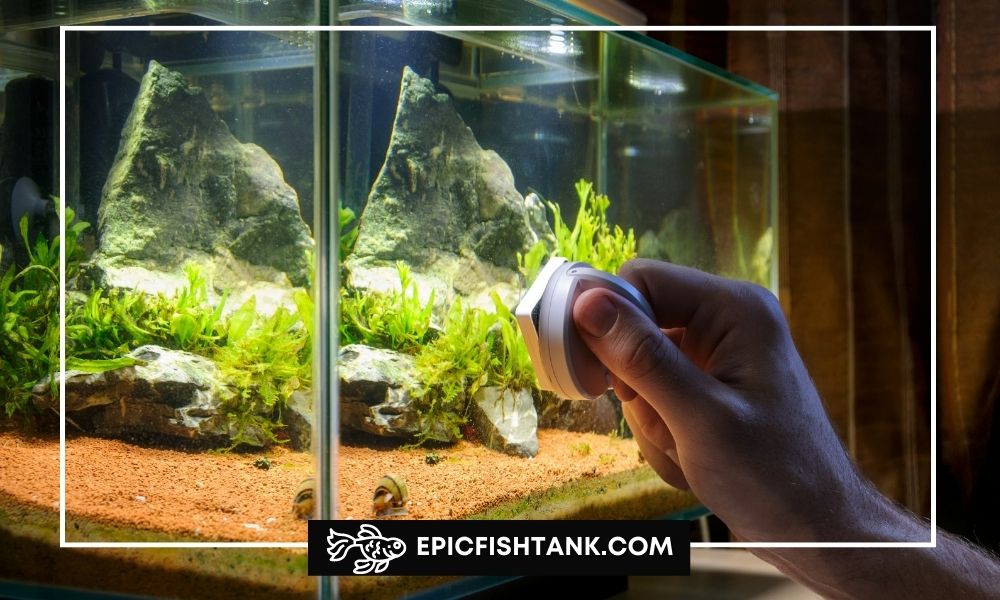How to Cycle a Fish Tank: Fish-In & Fishless Cycle Methods
Master the nitrogen cycle in aquariums with our comprehensive guide. We will guide you through every part of the aquarium cycle methods.
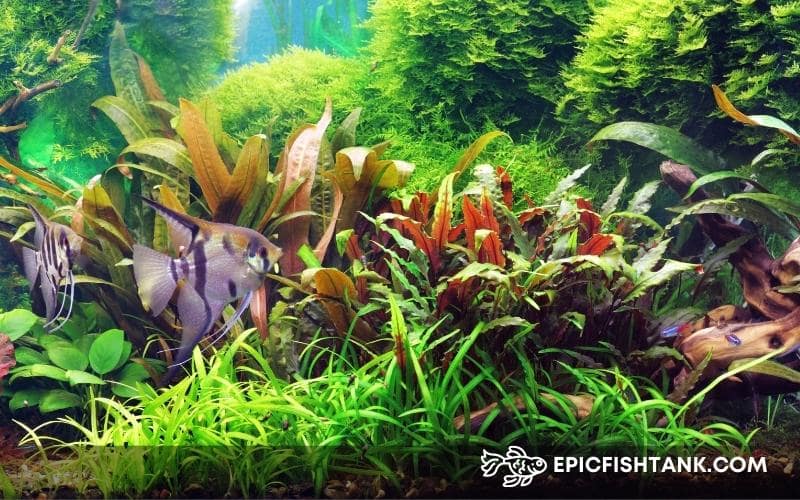
If you recently purchased a tank, then you may be interested in cycling it to provide your fish with a safe and healthy environment. To accomplish this, two methods are commonly used: the fishless cycle and the fish-in cycle.
Let’s start by taking a look at the Stage of Nitrogen Cycle, to get an understanding of what’s involved in aquarium cycling.
The Stage of Nitrogen Cycle
💡The nitrogen cycle is an important aspect of keeping aquariums healthy, and it consists of three stages: ammonia, nitrite, and nitrate. It is essential to learn about the dangers that each stage can pose to fish so that they remain safe.
- When ammonia levels become too high, fish can become very stressed or even suffer irreversible damage.
- High levels of nitrites are also dangerous, as they interfere with the oxygen-carrying capacity of fish’s blood and make them more prone to disease.
- Finally, while nitrates don’t typically cause direct harm to fish, levels that remain too high within an aquarium increase the chance for algae growth and other adverse effects.
To learn more about ecosystems like these and how to keep them healthy for your fishy friends, you can check the below table for insight into each stage’s dangerous level.
| Stage of Nitrogen Cycle | Dangerous Level | Effect |
|---|---|---|
| Ammonia | High levels (above 0.05 mg/L) can be toxic to fish, causing damage to gills, fins, and skin. | Fish may show symptoms such as rapid gill movement, redness and swelling, difficulty breathing, and in severe cases, death. |
| Nitrite | High levels (above 0.5 mg/L) can be harmful to fish and can cause difficulty breathing, respiratory distress, and even death. | Fish may show symptoms such as gasping at the surface, brown or reddish gills, and lethargy. |
| Nitrate | High levels (above 20-40 mg/L) can cause stress and disease in fish, and can also lead to the growth of harmful algae. | Fish may show symptoms such as lethargy, loss of appetite, and reproductive issues. High nitrate levels may also lead to the growth of unwanted algae and other aquatic plants, which can affect the overall health of the tank. |
Nitrogen Cycle Processes Infographic
This infographic outlines the main processes of this cycle, which generally consists of nitrogen entering an aquarium, being converted into usable form for plants and aquatic animals, and then leaving the aquarium by way of filtration or water changes. Learn more about the nitrogen cycle processes here.
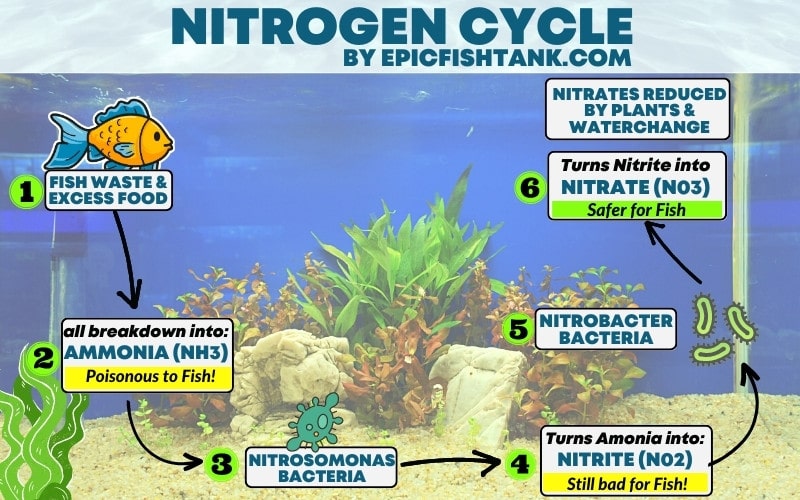
How to Cycle Your New Tank
In this guide, we’ll be taking a look at how to cycle a fish tank using both fish-in and fishless cycle methods. Whether you have a betta, guppies, or goldfish, these methods can help you create the perfect environment for your new pet.
💡Regardless of which method you choose, both involve introducing beneficial bacteria for a secure habitat for your aquatic friends. With either cycling method you can rest assured that your fish will receive all the necessary ingredients that their bodies require for survival.
How to Fish-in Cycle (Traditional Ways)
Fish-in cycling is a method of establishing beneficial bacteria in an aquarium by introducing hardy fish into the tank.
The fish produce waste, which serves as food for the beneficial bacteria. The bacteria then convert the waste into less harmful compounds, such as nitrite and nitrate.
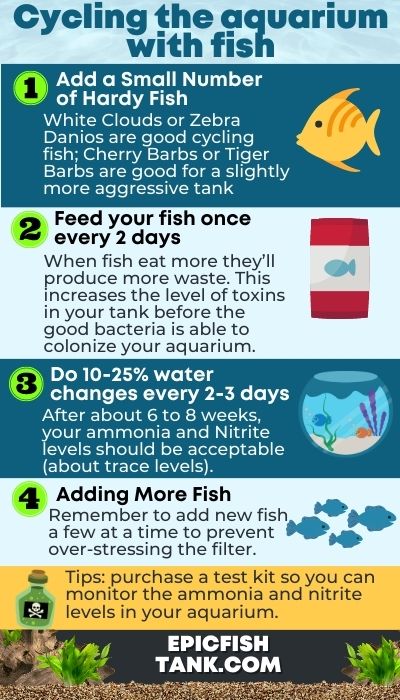
Here is a quick guide of the fish-in cycling method:
- Set up your aquarium by adding the appropriate amount of water, equipment, and decorations.
- Introduce hardy fish, such as zebra danios, tetra or guppies, into the tank. It’s important to only add a small number of fish at first and to avoid overstocking.
- Monitor the water parameters using test kits for ammonia, nitrite, and nitrate levels. Keep an eye out for any signs of stress or illness in the fish.
- Feed the fish a small amount of food, as overfeeding can lead to an increase in waste and ammonia levels.
- As the fish produce waste, the beneficial bacteria will start to grow and convert the waste into nitrite, then nitrate.
- As the nitrite levels begin to drop and nitrate levels begin to rise, perform water changes to lower the nitrate levels.
- Once nitrate levels are consistently present, the tank is considered cycled and ready for more sensitive fish species.
EpicFishTank Note:
It’s important to note that this process can take several weeks and it’s important to monitor the water parameters regularly and make adjustments as necessary to maintain the health and well-being of the fish.
Pros of Fish-in Cycling:
- It is a natural process that occurs in nature, so it may be more effective than artificial methods.
- It can be less difficult to monitor, as the fish will produce waste that can be used to establish the beneficial bacteria.
Cons of Fish-in Cycling:
- It can be more stressful on the fish, as they are introduced to the aquarium before the cycling process is complete.
- It can take longer to complete than fishless cycling, as the growth of beneficial bacteria is dependent on the amount of waste produced by the fish.
- There is a risk of fish death during the cycling process if the parameters of the water are not monitored closely.
How to Fishless Cycle
Fishless cycling is a method of establishing beneficial bacteria (nitrobacter) in a new tank, without the use of live fish.
Fishless cycling can be done by adding a source of ammonia, such as pure ammonia or fish food, to the aquarium water, and then monitoring the levels of ammonia, nitrite, and nitrate over time.
This method can be less stressful on the fish and can be completed more quickly than traditional cycling.
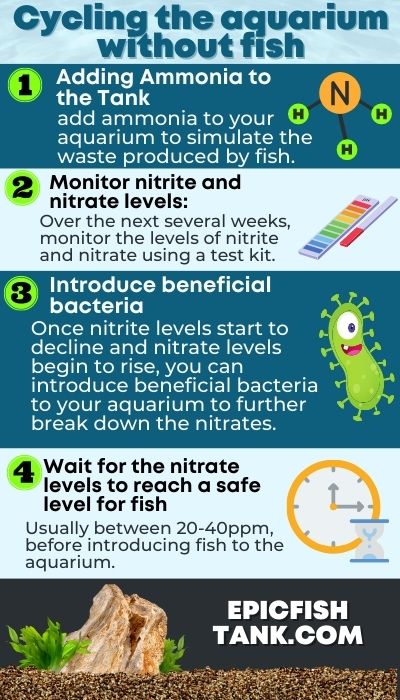
In order to cycle the tank without using fish, there are several steps you need to follow.
- Set up your aquarium by adding the appropriate amount of water, equipment, and decorations.
- Add an artificial source of ammonia to the tank, this can be done using pure ammonia or fish food.
- Monitor the water parameters using test kits for ammonia, nitrite, and nitrate levels.
- As the ammonia levels begin to drop, nitrite levels will start to rise. This is an indication that the beneficial bacteria are starting to grow and convert the ammonia into nitrite.
- As the nitrite levels begin to drop, nitrate levels will start to rise. This indicates that the beneficial bacteria are converting the nitrite into nitrate.
- Once nitrate levels are consistently present, the tank is considered cycled and ready for fish.
- Before adding fish to the tank, it is recommended to do a water change to reduce nitrate levels.
Pros of Fishless Cycling:
- It is less stressful on the fish, as they do not need to be introduced to the aquarium until the cycling process is complete.
- It can be completed more quickly than traditional cycling, as the addition of a source of ammonia can speed up the growth of beneficial bacteria.
- Fishless cycling can be useful for people who do not have access to hardy fish to use for cycling.
- It eliminates the risk of fish death during the cycling process.
Cons of Fishless Cycling:
- It may require more equipment and materials, such as test kits and pure ammonia, than traditional cycling.
- It may not be as effective as traditional cycling in some cases, as it is not a natural process.
EpicFishTank Pro Tips:
It’s important to note that there are other methods of establishing beneficial bacteria in a new fish tank, like using established filter media, live rock, or bacteria cultures and each method has its own pros and cons that you should consider before starting your new tank.
How to Speed Up Fishless Cycling
Use a bacterial starter
Fishless cycling enables you to introduce fish into a tank quickly and safely. To speed up the process, bacterial starters can be used to help the cycle progress at a much faster rate.
The bacteria in starter products typically take days rather than weeks or months to establish in the tank, giving your tank’s environment time to reach optimal conditions for new fish inhabitants.
In addition to adding beneficial bacteria, these starters also contain enzymes that help break down organic matter, removing nitrates from the water which are critical for accelerated cycling.
Buy well used filter
One simple and cost-effective method is to start with a foam filter from your local fish store that has been in use for some time. The existing bacteria will give your tank a head start on the cycling process, presuming that the filter was taken from a well-maintained tank.
Not only does this cut weeks off the cycling timeline, but it also ensures that beneficial bacteria are already established by the time you introduce any fish to the tank.

Fishless Cycling VS Fish-in Cycling
Note: this table is a summary of the information provided above, it’s important to consider all the factors when choosing which method to use.
| Parameters | Fishless Cycling | Fish-in Cycling |
|---|---|---|
| Stress on Fish | Low | High |
| Completion Time | Quick | Slow |
| Access to hardy fish | Not required | Required |
| Risk of fish death | None | Present |
| Monitoring levels | More difficult | Less difficult |
| Equipment and materials | More required | Less required |
| Effectiveness | May be less | May be more |
| Natural process | No | Yes |
The Initial & Maintenance Cost
| Fishless Cycling | Fish-in Cycling | |
|---|---|---|
| Initial cost | Moderate to High | Low to Moderate |
| Maintenance cost | Low | Moderate to High |
The initial cost of fishless cycling may be higher than fish-in cycling, as it may require more equipment and materials such as test kits, pure ammonia, or bacteria cultures. However, the maintenance cost of fishless cycling is generally lower, as there is no need to purchase and feed hardy fish during the cycling process.
On the other hand, fish-in cycling may have a lower initial cost, as it only requires the purchase of hardy fish. But the maintenance cost can be higher, as the fish need to be fed and the water parameters need to be closely monitored to prevent fish death during the cycling process.
Cost & Equipment on Both Method
It’s important to note that prices may vary depending on location and brand, and it’s recommended to shop around and compare prices before purchasing. Also, some of the items may not be necessary depending on the specific method you choose.
Fish-in Cycling:
- Test kits for measuring ammonia, nitrite, and nitrate levels (around $10-20 each)
- Hardy fish such as tetra (around $3-15 per fish)
- Fish food (around $5-10 per pound)
Fishless Cycling:
- Test kits for measuring ammonia, nitrite, and nitrate levels (around $10-20 each)
- Pure ammonia (around $5-10 per quart)
- Fish food (around $5-10 per pound)
- Air pump and air stone (around $10-20)
- Bacteria culture (around $10-20)
FAQs
What Should I Do if My Nitrogen Cycle is Not Established?
If your nitrogen cycle is not established, it may be due to one of three main problems.
The first being a lack of beneficial bacteria in the aquarium.
The second being an overload of waste from fish and uneaten food, which can overwhelm the bacteria.
Lastly, it may be due to insufficient aeration or poor water quality, both of which can slow down the growth of beneficial bacteria.
Master the nitrogen cycle in aquariums with our comprehensive guide. Our team We will guide you through every part of the aquariums nitrogen cycle process, so that you can thoroughly understand this essential subject matter.
Conclusion
Cycling a fish tank is an essential process for any aquarist. Whether you choose to perform a Fish-in Cycle or a Fishless Cycle, your patience and diligence will result in a healthy and sustainable tank for your finned friends.
Both methods have their advantages, so the best option depends on the individual circumstances of each case. Regardless of which method you choose, make sure you are aware of all the steps involved, from water testing to fish selection.
With proper knowledge and preparation, every aquarium can be successful!
Glossarium
- Ammonia: A toxic compound that is produced when organic matter decomposes.
- Nitrite: A less toxic form of ammonia, it is still harmful to fish in high concentrations.
- Nitrate: The least poisonous form of nitrogen, it can still cause problems if it accumulates in an aquarium.
- mg/L – milligrams per liter; it is a measurement of the concentration of a substance present in water, used to measure the levels of ammonia, nitrite, and nitrate.
References
- rlearley.people.ua.edu | Fishless Cycling, a primer
- wikipedia.org | Fishless cycling
Author
Reza is a digital marketer and an avid freshwater aquarist. He's been keeping fish tanks for more than 10 years and has always been fascinated by the delicate balance of life in water. Reza loves to share his knowledge about both digital marketing and fishkeeping with others, and he is always happy to help new aquarists get started in this rewarding hobby.
Wibisono is a freshwater fish breeder who raises and breeds different species of ornamental fish like betta, guppy, flowerhorn, and goldfish. He has been in the business since 2018 and exports his fish to different countries. He is committed to providing high-quality and healthy fish to his customers.

